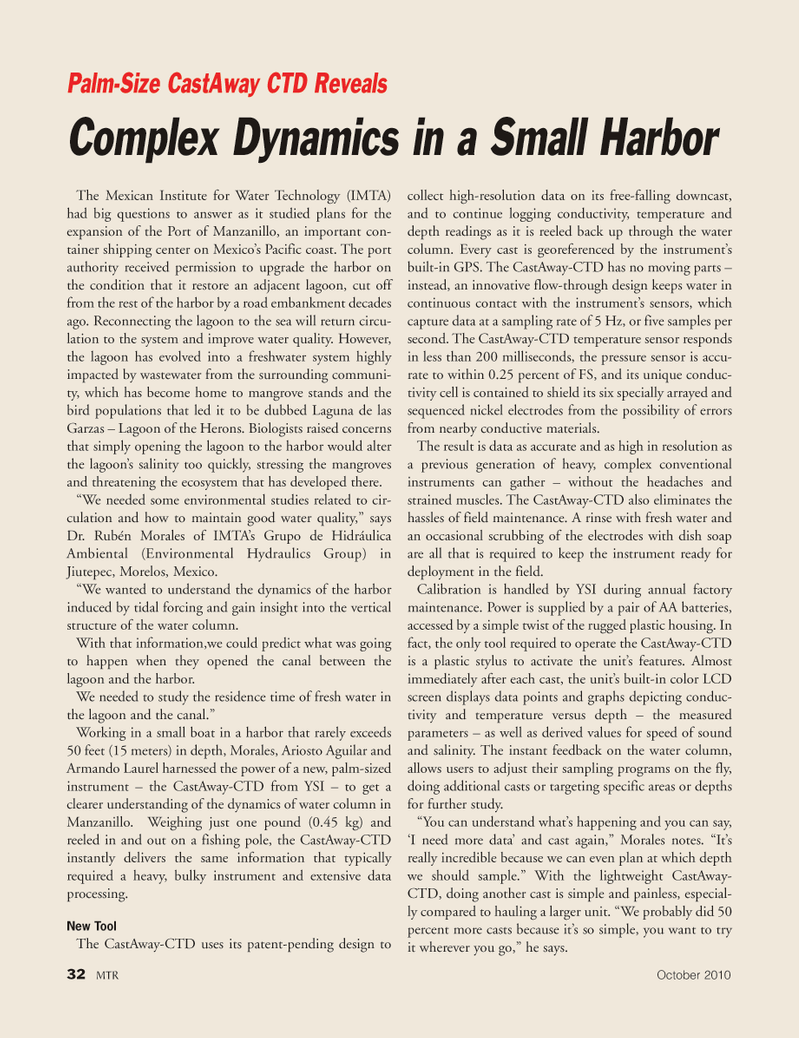
Page 32: of Marine Technology Magazine (October 2010)
Ocean Engineering & Design
Read this page in Pdf, Flash or Html5 edition of October 2010 Marine Technology Magazine
The Mexican Institute for Water Technology (IMTA) had big questions to answer as it studied plans for the expansion of the Port of Manzanillo, an important con- tainer shipping center on Mexico’s Pacific coast. The port authority received permission to upgrade the harbor on the condition that it restore an adjacent lagoon, cut off from the rest of the harbor by a road embankment decades ago. Reconnecting the lagoon to the sea will return circu- lation to the system and improve water quality. However, the lagoon has evolved into a freshwater system highly impacted by wastewater from the surrounding communi- ty, which has become home to mangrove stands and the bird populations that led it to be dubbed Laguna de las
Garzas – Lagoon of the Herons. Biologists raised concerns that simply opening the lagoon to the harbor would alter the lagoon’s salinity too quickly, stressing the mangroves and threatening the ecosystem that has developed there. “We needed some environmental studies related to cir- culation and how to maintain good water quality,” says
Dr. Rubén Morales of IMTA’s Grupo de Hidráulica
Ambiental (Environmental Hydraulics Group) in
Jiutepec, Morelos, Mexico. “We wanted to understand the dynamics of the harbor induced by tidal forcing and gain insight into the vertical structure of the water column.
With that information,we could predict what was going to happen when they opened the canal between the lagoon and the harbor.
We needed to study the residence time of fresh water in the lagoon and the canal.”
Working in a small boat in a harbor that rarely exceeds 50 feet (15 meters) in depth, Morales, Ariosto Aguilar and
Armando Laurel harnessed the power of a new, palm-sized instrument – the CastAway-CTD from YSI – to get a clearer understanding of the dynamics of water column in
Manzanillo. Weighing just one pound (0.45 kg) and reeled in and out on a fishing pole, the CastAway-CTD instantly delivers the same information that typically required a heavy, bulky instrument and extensive data processing.
New Tool
The CastAway-CTD uses its patent-pending design to collect high-resolution data on its free-falling downcast, and to continue logging conductivity, temperature and depth readings as it is reeled back up through the water column. Every cast is georeferenced by the instrument’s built-in GPS. The CastAway-CTD has no moving parts – instead, an innovative flow-through design keeps water in continuous contact with the instrument’s sensors, which capture data at a sampling rate of 5 Hz, or five samples per second. The CastAway-CTD temperature sensor responds in less than 200 milliseconds, the pressure sensor is accu- rate to within 0.25 percent of FS, and its unique conduc- tivity cell is contained to shield its six specially arrayed and sequenced nickel electrodes from the possibility of errors from nearby conductive materials.
The result is data as accurate and as high in resolution as a previous generation of heavy, complex conventional instruments can gather – without the headaches and strained muscles. The CastAway-CTD also eliminates the hassles of field maintenance. A rinse with fresh water and an occasional scrubbing of the electrodes with dish soap are all that is required to keep the instrument ready for deployment in the field.
Calibration is handled by YSI during annual factory maintenance. Power is supplied by a pair of AA batteries, accessed by a simple twist of the rugged plastic housing. In fact, the only tool required to operate the CastAway-CTD is a plastic stylus to activate the unit’s features. Almost immediately after each cast, the unit’s built-in color LCD screen displays data points and graphs depicting conduc- tivity and temperature versus depth – the measured parameters – as well as derived values for speed of sound and salinity. The instant feedback on the water column, allows users to adjust their sampling programs on the fly, doing additional casts or targeting specific areas or depths for further study. “You can understand what’s happening and you can say, ‘I need more data’ and cast again,” Morales notes. “It’s really incredible because we can even plan at which depth we should sample.” With the lightweight CastAway-
CTD, doing another cast is simple and painless, especial- ly compared to hauling a larger unit. “We probably did 50 percent more casts because it’s so simple, you want to try it wherever you go,” he says. 32 MTR October 2010
Palm-Size CastAway CTD Reveals
Complex Dynamics in a Small Harbor

 31
31

 33
33
